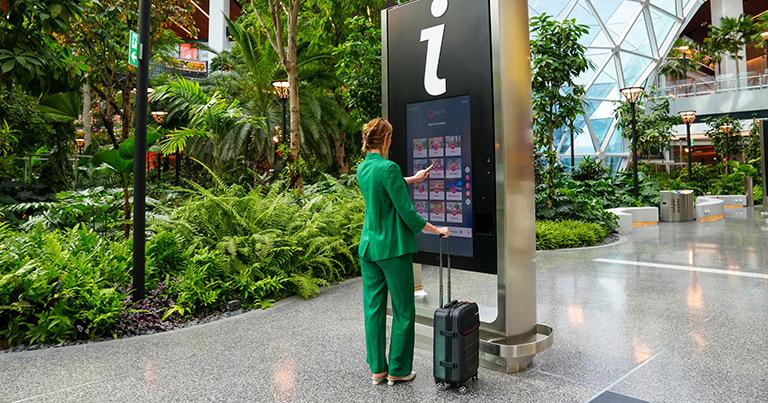Generative AI, the good, the bad, and the risky
by Gustavo Pina Director of SITA Lab
Gus Pina is the Director of SITA Lab, the company’s strategic research and development arm. Created in 2008, SITA Lab explores new technology. It drives innovations for the air transport community, working independently and in partnership with others on pilot projects in robotics, big data, AI, wearable technology, and many others.
With 25 years in the IT industry, Gus has always been passionate about transforming business processes with emerging technologies. Prior to SITA, Gus spearheaded key roles in digital transformations across FedEx, Delta Air Lines, and Macy’s. We spoke to him to determine what drives SITA’s innovation roadmap.
The evolution of AI in chatbots
The last year has seen significant announcements and global public attention towards emerging Artificial Intelligence (AI) and Large Language Model (LLM) platforms like ChatGPT. Capturing both the public’s imagination and sparking fears around the rapid evolution of these transformative technologies, many industries are now speculating over the future of their products and services in a shifting technological landscape.
Chatbots and virtual assistants are among the most common use cases of customer-facing generative AI in the air transport industry. The rise of chatbots and virtual assistants expanded in the 2010s with the likes of Siri and Alexa. Like many other customer-facing industries, the air transport industry started leveraging the trend for AI-driven chatbot customer services.
Before the availability of generative AI technology, chatbots were relatively limited in capability and required significant investment in development, training and tuning. Generative AI, and in particular LLMs such as ChatGPT, can make the user experience much richer without the resource of expensive machine learning training. They also provide a much broader knowledge base to work from.
Back in 2017, a small percentage of airlines and airports used AI-driven chatbots. We predicted that by 2020 68% of airlines and 42% of airports would have plans to adopt AI-driven chatbot services offering customer support.
Our latest Air Transport IT Insights finds that the adoption of AI will continue to increase: airlines (76%) and airports (68%) are planning major programs, or R&D, for AI by 2025.
Some of these programs today are directly customer-facing. For example, Etihad plans to use AI to enable passengers to book flights: Etihad Becomes The Latest Airline To Embrace AI Chatbots (simpleflying.com).
Clearly, while AI, and generative AI, are still relatively new, they have the potential to transform travel.
Harnessing AI in the air transport industry today
As a global IT and communications provider for the travel and transport industry, we continuously explore and leverage emerging technologies to transform business models and processes – to help the industry reduce costs, overcome operational hurdles, and improve the passenger experience.
Starting with our SITA Lab innovation team and expanding across our product portfolios, we thrive on solving the industry challenges of today and tomorrow. SITA Lab explores new technology and drives innovations for the air transport community, working independently and in partnership with others on pilot projects in robotics, big data, AI, wearable technology, and many others.
While there are risks, generative AI’s opportunities for the air transport industry are immense. As part of our continuing work around AI, we are exploring numerous use cases to streamline processes, drive new operational insights and improve collaboration between airlines, airports, governments, and other stakeholders.
For instance, much process interaction between these stakeholders is through text-based document exchange (for legacy reasons). LLMs make it possible to extract meaning and intent from these human-readable documents into machine-readable and interpretable information. This bridge from human-readable text to digital computer interfaces will enhance greater collaboration and knowledge sharing, speeding up processes and enhancing industry efficiencies.
Today, we use AI, including machine learning, for data analytics, in several ways. See a few examples outlined below:
(1) We offer SITA OptiClimb® as part of our SITA OptiFlight® suite of solutions, the industry’s only machine-learning solutions that analyze aircraft data and weather to optimize fuel and flight paths. The SITA OptiClimb® solution, aimed at airlines, delivers fuel savings of 5% for each flight while reducing annual CO2 emissions by thousands of tons and operational costs by millions of dollars.
(2) Our SITA WorldTracer® Lost and Found Property leverages machine learning and several other emerging technologies to solve the global multi-million lost property problem by handling lost and found issues promptly and accurately, reuniting passengers with their lost property, and ensuring GDPR compliance.
The technology behind the solution searches a global database of images and descriptions to match the found item to a missing item report. The solution uses image recognition to identify details such as the missing item’s brand, material, and color. It also recognizes similar words in the description to make a definitive match.
Lost and Found Property cuts the cost of repatriating lost items by 90%. Airline employees can register a found item, create a missing item report, and validate a match in under two minutes. The solution also dramatically speeds up the time taken to find and return found items, with 60% of these items returned within the first 48 hours.
(3) Our border technologies are leveraging AI too. For example, we use it in our biometric identification technologies that support more modern border control procedures to increase security, improve border agencies’ operational efficiency, and generally provide a more pleasurable immigration experience for the traveler.
We use AI to rapidly improve the performance of face recognition software to a point where they meet and even exceed the performance of other biometric modalities, such as iris and fingerprint, while being more convenient. A combination of more powerful edge processors with machine learning models is enabling face recognition on devices like mobile phones and smart security cameras.
(4) In our SITA Lab, we are developing next-generation digital assistants that leverage LLMs to create much richer chatbot-type interfaces than the first-generation chatbots. These bots have access to a combination of airport manuals, passenger points of interest, and real-time operational data. These assistants can be deployed at the airport to augment existing information service desks or within airline and airport apps.
We are also developing digital assistants to assist with airport operations systems. The assistant can provide advice on routine operational decisions, freeing up time for the airport staff to deal with more complex scenarios.
(5) AI is being used to help us resolve our airport customers’ technical issues, enhance communications, and increase customer self-service through virtual agents.
Here at SITA, we see great potential for generative AI across the entire travel and transport industry and we will leverage more of it to improve the effectiveness of our solutions and services to support the industry.
Assessing the risks of AI
There are many opportunities that we are exploring with AI. Of course, AI has several potential risks, from privacy violations to discrimination.
In addition to the traditional machine-learning risks, generative AI brings a new category of risk. The most commonly known is when ChatGPT ‘hallucinates’ and provides answers that sound convincing but are wrong or just invented. In the case of LLMs, careful use of Prompt Engineering and limiting the LLM to a specific data source (such as an airport’s operations manual) can prevent this from happening.
Until trust in these systems is established, it is important to have a human in the decision-making process and to build guardrails to autonomous systems.
source : https://tinyurl.com/49j6d3wk




